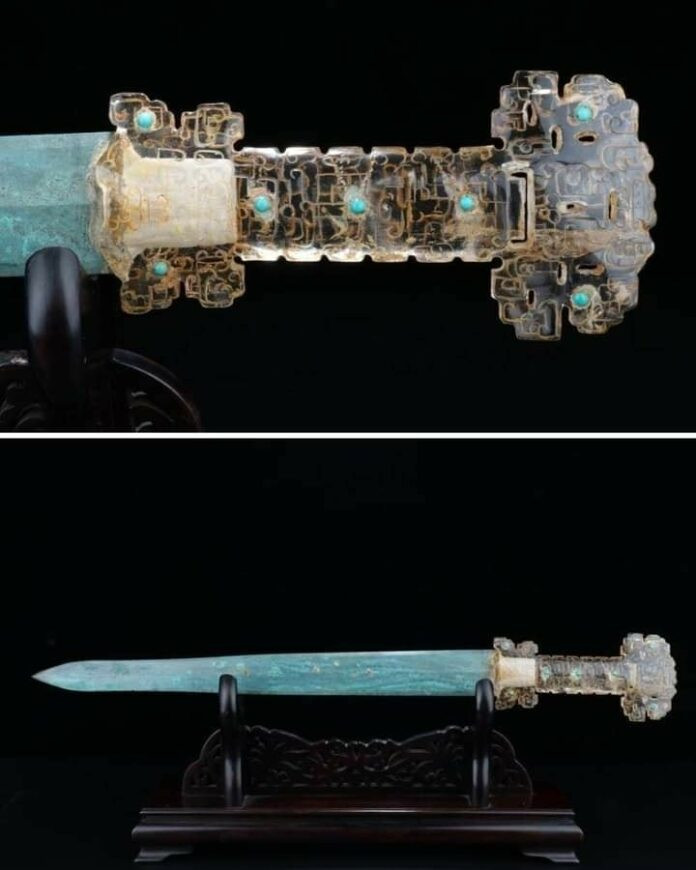In the vast and fascinating world of ancient artifacts, few objects capture the imagination and intellect quite like a finely crafted weapon from a long-lost civilization. Among these, one stands out as a particularly striking example of both artistic excellence and technical innovation: a Chinese bronze sword from the Warring States period, dating back to the 4th to 2nd century B.C. This magnificent relic, featuring a hilt inlaid with rock crystal, turquoise, and gold, serves as more than just a symbol of power—it is a window into the sophisticated culture, turbulent history, and remarkable craftsmanship of ancient China.

The creation of this sword occurred during one of the most chaotic and politically fragmented periods in Chinese history. The Warring States period was characterized by constant warfare among rival kingdoms, each vying for dominance and survival. Amid this backdrop of conflict and power struggles, artisans and engineers thrived, pushing the boundaries of their craft. The bronze sword is a product of this environment—a physical embodiment of the ingenuity and artistic skill that flourished even in times of great unrest.
What immediately sets this sword apart is its delicate balance between functionality and beauty. The blade itself, narrow and formidable, was designed not only for effective use in combat but also to convey a sense of refinement and elegance. It is likely that such a weapon would have inspired both fear and admiration on the battlefield, a testament to the skill and precision of its makers. Yet, it is the hilt of the sword that truly commands attention, elevating the piece from mere weapon to masterpiece.
Carefully adorned with inlays of rock crystal, turquoise, and gold, the hilt reflects a level of craftsmanship that speaks volumes about the artisans’ expertise and the owner’s social standing. The choice of materials was far from arbitrary. Rock crystal, with its transparent and luminous qualities, was highly valued in ancient times for both its beauty and its perceived spiritual properties. Believed to offer protection and mystical power, the inclusion of rock crystal may have imbued the sword with a sense of otherworldly strength, perhaps intended to shield its wielder in the chaos of battle.
Turquoise, with its vibrant blue-green hues, added not only visual contrast but also cultural significance. This stone was revered across ancient civilizations for its association with nobility, healing, and divine favor. Meanwhile, the use of gold—universally recognized as a symbol of wealth and power—further emphasized the sword’s importance and the high status of its owner. Together, these materials transformed the hilt into a display of opulence and authority, making it clear that the sword was far more than a simple tool of war.
Beyond its aesthetic appeal, the sword offers a wealth of historical insight. It serves as a tangible link to a pivotal moment in Chinese history, when advances in metallurgy, artistry, and military technology were rapidly evolving. The sword is not merely an object; it is a narrative in metal and stone, telling the story of a society that valued both the art of war and the beauty of craftsmanship. The individual who owned such a weapon was likely a figure of considerable influence—possibly a military leader or nobleman—who wielded not only physical power but also cultural significance.
Preserving artifacts like this sword is crucial to understanding the broader context of ancient civilizations. Each detail—the materials used, the techniques employed, the stylistic choices made—provides clues about the values, beliefs, and social structures of the time. As scholars continue to study such relics, they gain a deeper appreciation for the complexities of ancient Chinese society and the ways in which art, warfare, and politics were intertwined.
Moreover, this bronze sword stands as a symbol of human creativity and resilience. Despite the challenges and conflicts of the Warring States period, artisans continued to create works of lasting beauty and significance. Their efforts have transcended time, allowing modern audiences to marvel at their achievements and to reflect on the shared human drive to create, innovate, and express.
In sharing the story of this extraordinary artifact, we ensure that the legacy of the Warring States period endures. The sword invites us to look beyond its surface beauty and to consider the lives of those who forged it, wielded it, and lived in the world it represents. It encourages us to explore history not as a series of distant events but as a tapestry woven with the threads of individual lives, cultural milestones, and artistic triumphs.
Ultimately, the Chinese bronze sword from the Warring States period is more than a relic; it is a masterpiece of ancient craftsmanship, a testament to the intellect and artistry of its creators, and a lasting reminder of a civilization that valued both the power of the sword and the beauty it could embody. As we continue to study and preserve such artifacts, we not only honor the past but also enrich our understanding of humanity’s shared heritage. Through this connection to ancient times, we find inspiration, knowledge, and a profound respect for the enduring ingenuity of the human spirit.





